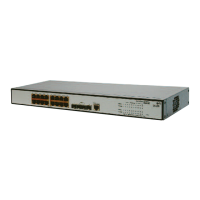1-26
Examples
# Set the maximum number of neighbors that can be dynamically learned on the interface
VLAN-interface 1.
<Sysname> system-view
System View: return to User View with Ctrl+Z.
[Sysname] interface Vlan-interface 1
[Sysname-Vlan-interface1] ipv6 neighbors max-learning-num 10
ipv6 route-static
Syntax
ipv6 route-static ipv6-address prefix-length [ interface-type interface-number] nexthop-address
undo ipv6 route-static ipv6-address prefix-length
View
System view
Parameters
ipv6-address prefix-length: Destination IPv6 address and prefix length.
interface-type interface-number: Type of egress interface and interface number.
nexthop-address: IPv6 address of the next hop.
Description
Use the Ipv6 route-static command to configure a static IPv6 route.
Use the undo ipv6 route-static command to remove a static IPv6 route.
By default, no IPv6 static route is configured.
If you specify the destination IP address of an IPv6 static route as ::/0, the route configured becomes a
default IPv6 route. If the destination IP address of a packet does not match any entry in the routing table,
the device will use a default IPv6 route to forward the IPv6 packet.
Related commands: display ipv6 route-table.
Examples
# Configure a static IPv6 route, with the destination address of 1:1:2::/48 and the next hop address of
1:1:3::1.
<Sysname> system-view
System View: return to User View with Ctrl+Z.
[Sysname] ipv6 route-static 1:1:2:: 48 1:1:3::1
# Configure a static IPv6 route, with the next hop address of 1:1:4::1.
<Sysname> system-view
System View: return to User View with Ctrl+Z.
[Sysname] ipv6 route-static :: 0 1:1:4::1

